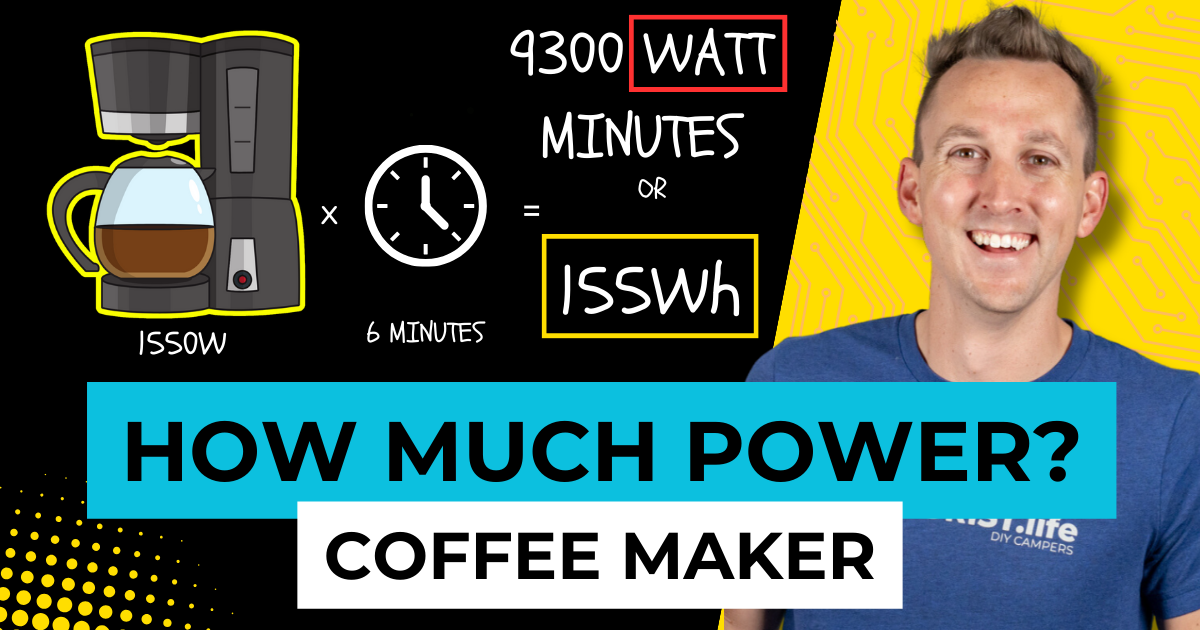A coffee maker is the most important thing we need to be able to power from a mobile, marine, or off-grid electrical system, because, let’s be honest; without coffee, nothing else we would need to power really matters.
But how much power does a coffee maker actually take to brew a pot of coffee? Well, that’s exactly what I’m going to teach you how to calculate here in lesson #1 of this Electrical System Sizing Chapter.
The methods of estimating power usage I’m going to teach you will work for many other appliances like induction cooktops, blenders, air fryers, and a lot more; so if you keep an open mind and think critically, you’ll be able to apply this information to your own specific project.
COMING SOON
Back in lesson 1.3 of this academy, I taught you how to calculate watt hours given watts and minutes, and that’s exactly what we are going to be using here.
First: We need to know how many watts the coffee maker takes to operate. If you already have the coffee maker you want to use, this will be listed on the spec sticker somewhere on the coffee maker or in the user manual.

Alternatively, you could look up the make/model of your coffee maker on Google, and you should be able to find out how many watts it uses if you look around a bit.

Also, remember from lesson 1.3; that if your appliance tells you how many amps it uses, you can convert from amps to watts by multiplying the amps of the device by the voltage of the source to get the operating watts of the device.
Our coffee maker uses 1550W when it is actively brewing, which is the first part of the equation.
A stopwatch will be your friend here, but our coffee maker takes 5 minutes and 54 seconds to brew a pot of coffee, which I’m going to round up to 6 minutes so I don’t have to deal with fractions of minutes, and we can plug that into our equation of Watt Hours = Watts x Minutes / 60 from earlier:
1550 watts * 6 Minutes / 60 minutes per hour gives us 155 Watt Hours to brew this pot of coffee.

Once this coffee maker finishes brewing, it enters a low-power mode for a period of time after brewing to keep the coffee warm; but unfortunately, with the information we have at the moment, there is no way to estimate how much additional power the ‘keep warm’ function will use; but keep reading and I’ll show you how to figure that out.
I bought some AC power meters on Amazon for about $15 and although it takes a bit longer, it’s pretty precise and gives a lot more detail into how much power is flowing through the meter at any given time. Plus a running total of how much power has gone through the meter which can be reset for accurate reporting
So this meter shows me that when the coffee maker is brewing, it is operating at just a bit over it’s rated wattage; and it’s also keeping a tally of how much power has used since it was reset last, right before brewing this pot of coffee. And yesterday, I brewed a pot of coffee and let it also go through it’s ‘keep warm’ cycle and here are the results:
1569W for 5 minutes and 54 seconds results in .14kWH being used, or 140 watt hours; which is pretty close to our calculation from earlier.

During the 1 hour and 10 minute ‘keep warm’ cycle, the coffee maker cycled off and on, using anywhere from 0 to 100 watts; and our energy meter tells us that .085 kWH or 85Wh passed through the meter during that keep warm cycle.

This totals up to 225Wh being pulled from the wall outlet to brew a pot of coffee and keep it warm for an hour and ten minutes.
For context, 225 watt hours pulled from a 12V battery bank would be a loss of 18.75 amp hours, or 18.75% being drawn from a 100Ah battery, per pot of coffee brewed, not counting any kind of inverter efficiency losses.

When Steph and I were living in our van full time, we had a coffee maker that had an insulated pot; so once the brew cycle was done, the coffee maker turned off, and then the insulated pot kept the coffee warm for hours; which gets rid of the ‘keep warm’ cycle altogether. Just something to consider.

Now you should have a good idea of how to calculate the power used by a coffee maker for your mobile, marine, or off-grid electrical system; and you can use these principles to figure out the power usage of many other items like air fryers, instant pots, blenders and more. The quick and dirty method of using the listed device wattage multiplied by the time used is good, but picking up an AC meter for precise measurements is a great tool to have in your belt.
We will refer to this video later in this academy when we discuss full power audits, so be sure to bookmark it for future reference and come back to it if you need a refresher.
In the next lesson, I’m going to teach you how to determine the power required for a cell phone. I’ll see you over there.


